Virgin birth of Jesus
The virgin birth of Jesus is the doctrine that Jesus was conceived and born by his mother Mary through the power of the Holy Spirit and without sexual intercourse with her husband Joseph.[1] The Orthodox churches accept it as authoritative by reason of its inclusion in the Nicene Creed,[2] the Catholic church likewise holds it authoritative for faith through the Apostles' Creed as well as the Nicene, and Protestants regard it as an explanation of the mixture of the human and divine natures of Jesus;[1] but although it has clear scriptural backing in two gospels, the consensus of modern scholars is that its historical foundations are very flimsy.[3]
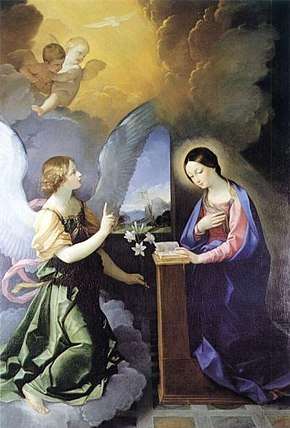
Doctrine
The virgin birth is the doctrine that Jesus was conceived and born by his mother Mary through the power of the Holy Spirit and without sexual intercourse with her husband Joseph.[1] It is attested in the gospels of Matthew and Luke and affirmed in both the Apostles' Creed (c. 2nd century) and the Nicene Creed (381 AD),[4] and the Orthodox, Catholic and Protestant churches all accept it as either authoritative for faith or an explanation of the mixture of the human and divine natures of Jesus;[2][1] nevertheless, there are many contemporary churches in which it is considered orthodox to accept the virgin birth, but not heretical to deny it.[5]
History
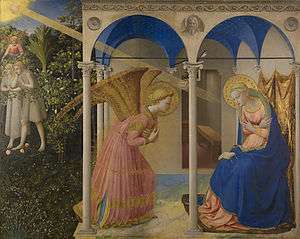
Scriptural attestation: Matthew 1:18-25 and Luke 1:26-38
The Gospels of Matthew and Luke agree that Mary's husband was named Joseph, that he was of the Davidic line, and that he played no role in Jesus's divine conception, but beyond this they are very different.[6][7] Matthew underlines the virginity of Mary by references to the Book of Isaiah (using the Greek translation in the Septuagint, rather than the mostly Hebrew Masoretic Text) and by his narrative statement that Joseph had no sexual relations with her until after the birth (a choice of words which leaves open the possibility that they did have relations after that).[8]
18: Now the birth of Jesus the Messiah took place in this way. When his mother Mary had been engaged to Joseph, but before they lived together, she was found to be with child from the Holy Spirit.
19: Her husband Joseph, being a righteous man and unwilling to expose her to public disgrace, planned to dismiss her quietly.
20: But just when he had resolved to do this, an angel of the Lord appeared to him in a dream and said, "Joseph, son of David, do not be afraid to take Mary as your wife, for the child conceived in her is from the Holy Spirit.
21: She will bear a son, and you are to name him Jesus, for he will save his people from their sins."
22: All this took place to fulfill what had been spoken by the Lord through the prophet:
23: "Look, the virgin shall conceive and bear a son, and they shall name him Emmanuel," which means, "God is with us."
24: When Joseph awoke from sleep, he did as the angel of the Lord commanded him; he took her as his wife,
25: but had no marital relations with her until she had borne a son; and he named him Jesus.
Luke introduces Mary as a virgin, describes her puzzlement at being told she will bear a child despite her lack of sexual experience, and informs the reader that this pregnancy is to be effected through God's Holy Spirit.[9]
26: In the sixth month the angel Gabriel was sent by God to a town in Galilee called Nazareth,
27: to a virgin engaged to a man whose name was Joseph, of the house of David. The virgin's name was Mary.
28: And he came to her and said, "Greetings, favored one! The Lord is with you."
29: But she was much perplexed by his words and pondered what sort of greeting this might be.
30: The angel said to her, "Do not be afraid, Mary, for you have found favor with God.
31: And now, you will conceive in your womb and bear a son, and you will name him Jesus.
32: He will be great, and will be called the Son of the Most High, and the Lord God will give to him the throne of his ancestor David.
33: He will reign over the house of Jacob forever, and of his kingdom there will be no end."
34: Mary said to the angel, "How can this be, since I am a virgin?"
35: The angel said to her, "The Holy Spirit will come upon you, and the power of the Most High will overshadow you; therefore the child to be born will be holy; he will be called Son of God.
36: And now, your relative Elizabeth in her old age has also conceived a son; and this is the sixth month for her who was said to be barren.
37: For nothing will be impossible with God."
38: Then Mary said, "Here am I, the servant of the Lord; let it be with me according to your word." Then the angel departed from her.
Cultural context
The most likely cultural context for both Matthew and Luke is Jewish Christian or mixed Gentile/Jewish-Christian circles rooted in Jewish tradition.[10] The ancient world had no idea that male semen and female ovum were both needed to form a fetus; instead they thought that the male contribution in reproduction consisted of some sort of formative or generative principle, while Mary's bodily fluids would provide all the matter that was needed for Jesus' bodily form, including his male sex.[11] This cultural milieu was conducive to miraculous birth stories - they were common in biblical tradition going back to Abraham and Sarah.[12]
Tales of virgin birth and the impregnation of mortal women by deities were well known in the 1st-century Greco-Roman world,[13] and Second Temple Jewish works were also capable of producing accounts of the appearances of angels and miraculous births for ancient heroes such as Melchizedek, Noah, and Moses.[14] Luke's virgin birth story is a standard plot from the Jewish scriptures, as for example in the annunciation scenes for Isaac and for Samson, in which an angel appears and causes apprehension, the angel gives reassurance and announces the coming birth, the mother raises an objection, and the angel gives a sign.[15] Nevertheless, "plausible sources that tell of virgin birth in areas convincingly close to the gospels' own probable origins have proven extremely hard to demonstrate".[16] Similarly, while it is widely accepted that there is a connection with Zoroastrian (Persian) sources underlying Matthew's story of the Magi (the wise men from the East) and the Star of Bethlehem, a wider claim that Zoroastrianism formed the background to the infancy narratives has not achieved acceptance.[16]
The Gospel of Luke says Mary is a virgin betrothed to Joseph,[17] while the Gospel of Matthew says Jesus' virginal conception happens before Mary lives with Joseph in his house,[18] because, in a Jewish wedding, by being betrothed to a man, the woman is already his wife, yet she does not start living in his house until the wedding is over.[19][Notes 1] Mary's response to Gabriel - "How can this be, since I have no relations with a man?" (meaning, no sexual relations)[20]- is an affirmation of Mary the wife of Joseph's virginity and obedience to the Torah that forbids adultery.[21][22]
In the Gospel of Matthew, Joseph intends to divorce Mary on suspicion of adultery[23] because he is a righteous man, i.e., he is obedient to the Torah[24] that mandates divorcing one's unfaithful wife.[25][26] Because he is obedient, Joseph relents of his intention when, in a dream, he is informed by an angel of the virginal conception of Jesus.[27]
Arguments and evidence
Historicity
The modern scholarly consensus is that the tradition rests on very slender historical foundations.[3] In the entire Christian corpus the virgin birth is found only in the Gospel of Matthew and the Gospel of Luke:[28] both are probably from the period AD 80-100, both are anonymous (the attributions to Matthew and Luke were added in the 2nd century), and it is almost certain that neither was the work of an eyewitness.[29][30][31] Matthew and Luke did not find their story in Mark, nor did one of them derive it from the other, nor did they find it in a common source.[28] Raymond E. Brown suggested in 1973 that Joseph was the source of Matthew's account and Mary of Luke's, but modern scholars consider this "highly unlikely", given that the story emerged so late.[32] It follows that the two narratives were created by the two writers, drawing on ideas in circulation in some Christian circles perhaps by around 65 AD.[33]
Matthew uses Isaiah 7:14 to support his narrative, but scholars agree that the Hebrew word used in Isaiah, "almah", signifies a girl of childbearing age without reference to virginity, and was aimed at Isaiah's own immediate circumstances.[34][35] Paul does not mention it and assume Jesus's full humanity,[36] Mark, the earliest gospel, seems unaware that there was anything exceptional about the birth,[37] and in the Gospel of John Jesus has both father and mother (he is "the son of Joseph, whose father and mother we know" (John 4:21-22), repeating Philip's words to Nathanael at John 1:45, "We have found him about whom Moses in the law and also the prophets wrote, Jesus, son of Joseph from Nazareth"). [38]
Theology and development
Matthew and Luke use the virgin birth (or more accurately the divine conception that precedes it) to mark the moment when Jesus becomes the Son of God, a notable development over Mark, for whom the Sonship dates from Jesus's baptism, and the earlier Christianity of Paul and the pre-Pauline Christians for whom Jesus becomes the Son only at the resurrection or even the Second Coming.[39] The virgin birth was subsequently accepted by Christians as the proof of the divinity of Jesus, but its rebuttal during and after the 18th century European Enlightenment led some to redefine it as mythical, while others reaffirmed it in dogmatic terms.[40] This division remains in place, although some national synods of the Catholic church have replaced a biological understanding with the idea of "theological truth", and some evangelical theologians hold it to be marginal rather than indispensable to the Christian faith.[40]
Throughout Christian history a small number of groups have denied the virgin birth, particularly in the Near East.[41] The Ebionites considered Jesus the Messiah, but rejected his divine nature and regarded him as fully human.[42] The Nestorian Church and Assyrian Church of the East supported a physically human nature of Jesus.[43] Others, like Marcion, held that Christ's divinity meant that his human life, death and resurrection were only an appearance.[44] By about 180 AD Jews were telling how Jesus had been illegitimately conceived by a Roman soldier named Pantera or Pandera, whose name is likely a pun on parthenos, virgin.[45] The story was still current in the Middle Ages in satirical parody of the Christian gospels called the Toledot Yeshu.[46][47] The Toledot Yeshu contains no historical facts, and was probably created as a tool for warding off conversions to Christianity.[46] In America, the Strangite Mormon church denies the virgin birth of Christ, saying that his full humanity was indispensable if his sacrifice for sin was to be real.[48]
Celebrations, devotions and art
Celebrations and devotions
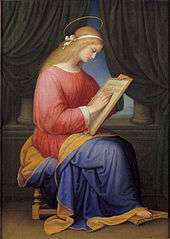
Christians celebrate the conception of Jesus on 25 March and his birth on 25 December. (These dates are for the Western tradition, no one knows for certain when Jesus was born.) The Magnificat, based on Luke 1:46-55 is one of four well known Gospel canticles: the Benedictus and the Magnificat in the first chapter, and the Gloria in Excelsis and the Nunc dimittis in the second chapter of Luke, which are now an integral part of the Christian liturgical tradition.[49] The Annunciation became an element of Marian devotions in Medieval times, and by the 13th century direct references to it were widespread in French lyrics.[50] The Eastern Orthodox Church uses the title "Ever Virgin Mary" as a key element of its Marian veneration, and as part of the Akathists (hymns) to Mary which are an integral part of its liturgy.[51]
This doctrine of the Virgin Birth is often represented in Christian art in terms of the annunciation to Mary by the Archangel Gabriel that she would conceive a child to be born the Son of God, and in Nativity scenes that include the figure of Salome. The Annunciation is one of the most frequently depicted scenes in Western art.[52] Annunciation scenes also amount to the most frequent appearances of Gabriel in medieval art.[53] The depiction of Joseph turning away in some Nativity scenes is a discreet reference to the fatherhood of the Holy Spirit, and the doctrine of Virgin Birth.[54]
Gallery of art
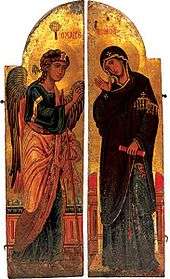 Holy Doors, Saint Catherine's Monastery on Mount Sinai in Egypt, 12th century
Holy Doors, Saint Catherine's Monastery on Mount Sinai in Egypt, 12th century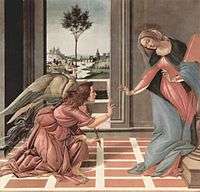 Sandro Botticelli (1489–90)
Sandro Botticelli (1489–90)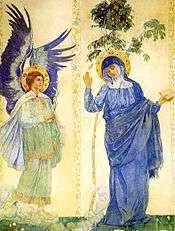 Mikhail Nesterov, Russia, 19th century
Mikhail Nesterov, Russia, 19th century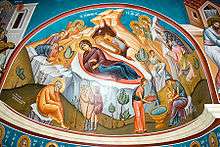 Eastern Orthodox Nativity depiction little changed in more than a millennium
Eastern Orthodox Nativity depiction little changed in more than a millennium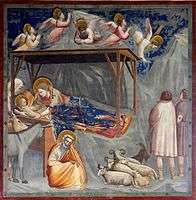 Giotto (1267–1337): Nativity with an uninvolved Joseph but without Salome
Giotto (1267–1337): Nativity with an uninvolved Joseph but without Salome
In Islam
According to Mustafa Akoyl, Muslims accept the Quranic story of Mary, including the virgin birth of Jesus, which most interpreters take literally.[55] Yet, Muslims reject the divinity of Jesus, which is explicitly rejected in the Quran.[56] The Quranic position has a precedent in Jewish Christianity, some streams of which accepted the virgin birth but rejected his divinity,[57] showing a "doctrinal connection between Jewish Christianity and Islam".[56]
In Surah Maryam, the virgin Mary conceives and gives birth to Jesus, then upon her return to her people they slander her. Mary does not respond except by pointing to her new born son, Jesus, who defends his mother by miraculously speaking.[58] The Islamic view holds that Jesus was God's word which he directed to Mary and a spirit created by him, moreover Jesus was supported by the Holy Spirit.[59]
According to Richard Bell, Muhammad appears to have gained his knowledge of the story through the late 2nd century Gospel of James rather than through the canonical gospels.[60] It does appear to have helped inform the Islamic tradition of the lives of Mary and Christ, and appears to directly relate to the references made to her piety in the pages of the Quran.[61][62]
See also
Notes
- Kiddushin (betrothal) is far more binding than an engagement as we understand the term in modern Western culture; in fact, Maimonides speaks of a period of engagement before the kiddushin. Once kiddushin is complete, the relationship can only be dissolved by death or divorce. However, the spouses do not live together at that time, and the mutual obligations created by the marital relationship do not take effect until the nisuin is complete.
References
Citations
- Carrigan 2000, p. 1359.
- Ware 1993, p. unpaginated.
- Bruner 2004, p. 37.
- Collinge 2012, p. 454.
- Barclay 1998, p. 55.
- Robinson 2009, p. 111.
- Lincoln 2013, p. 99.
- Morris 1992, p. 31-32.
- Carroll 2012, p. 39.
- Hurtado 2005, p. 328.
- Lincoln 2013, p. 195-196,258.
- Schowalter 1993, p. 790.
- Lachs 1987, p. 6.
- Casey 1991, p. 152.
- Kodell 1992, p. 939.
- Welburn 2008, p. 2.
- USCCB Luke 1:27
- USCCB Matthew 1:18
- Jewish Virtual Library: Marriage in Judaism
- USCCB Luke 1:34 commentary Mary’s questioning response is a denial of sexual relations and is used by Luke to lead to the angel’s declaration about the Spirit’s role in the conception of this child (Lk 1:35). According to Luke, the virginal conception of Jesus takes place through the holy Spirit, the power of God, and therefore Jesus has a unique relationship to Yahweh: he is Son of God.
- Jewish Encyclopedia: Adultery Sexual intercourse of a married woman with any man other than her husband. The crime can be committed only by and with a married woman; for the unlawful intercourse of a married man with an unmarried woman is not technically Adultery in the Jewish law.
- Jewish Virtual Library: Adultery The extramarital intercourse of a married man is not per se a crime in biblical or later Jewish law. This distinction stems from the economic aspect of Israelite marriage: the wife is the husband's possession, and adultery constitutes a violation of the husband's exclusive right to her; the wife, as the husband's possession, has no such right to him. Adultery is prohibited in the Decalogue (Ex. 20:13; Deut. 5:17), where it is listed between murder and theft (cf. Jer. 7:9; Ezek. 16:38; Hos. 4:2; Ps. 50:18; Prov. 6:30 ff.; Job 24:14–15) among offenses against one's fellow.
- USCCB Matthew 1:19
- USCCB Matthew 1:19 commentary as a devout observer of the Mosaic law, Joseph wished to break his union with someone whom he suspected of gross violation of the law. It is commonly said that the law required him to do so, but the texts usually given in support of that view, e.g., Dt 22:20–21 do not clearly pertain to Joseph’s situation...the penalty for proved adultery was death by stoning; cf. Dt 22:21–23.
- USCCB Deuteronomy 24:1
- Chabad Devarim - Deuteronomy - Chapter 24 [In this case] he has an obligation to divorce her, lest she find favor in his eyes [and he might consequently wish to keep her, which he must not do, since she had committed an act of impropriety]. — [Gittin 90b]
- USCCB Matthew 1:20-24
- Hurtado 2005, p. 318.
- Boring & Craddock 2009, p. 12.
- Fredriksen 2008, p. 7.
- Reddish 2011, p. 13.
- Lincoln 2013, p. 144.
- Hurtado 2005, p. 318-319,325.
- Sweeney 1996, p. 161.
- France 2007, pp. 56-57.
- Lincoln 2013, p. 21.
- Lincoln 2013, p. 23.
- Lincoln 2013, p. 24-25.
- Loewe 1996, p. 184.
- Kärkkäinen 2009, p. 175.
- McGuckin 2004, p. 286.
- Paget 2010, p. 360.
- Eirini Artemi, Cyril of Alexandria's critique of the term THEOTOKOS by Nestorius Constantinople, Acta theol. vol.32 no.2 Bloemfontein Dec. 2012
- Wahlde 2015, p. 62-63.
- Voorst 2000, p. 117.
- Cook 2011, p. unpaginated.
- Evans 1998, p. 450.
- Book of the Law of the Lord, Chapter XIV, "Note on the Sacrifice of Christ." Read at https://web.archive.org/web/20070925012552/http://www.mormonbeliefs.com/book_of_the_law_2.htm#CHAPTER XIV: EUCHARIST.
- Simpler 1990, p. 396.
- O'Sullivan, Daniel E., Marian devotion in thirteenth-century French lyric, 2005, ISBN 0-8020-3885-9, pp. 14–15.
- Peltomaa 2001, p. 127.
- Guiley, Rosemary, The encyclopedia of angels, 2004, ISBN 0-8160-5023-6, p. 183.
- Ross, Leslie, Medieval art: a topical dictionary, 1996, ISBN 0-313-29329-5, p. 99.
- Grabar, André, Christian iconography: a study of its origins, 1968, Taylor & Francis, p. 130.
- Akyol 2017, p. 126-127.
- Akyol 2017, p. 127-128.
- Akyol 2017, p. 128.
- al-Sheha, Abdul-Rahman. Prophet Jesus in the Quran. p. 45.
- Saritoprak, Zeki (2014). Islam's Jesus. Tampa: University Press of Florida. pp. 3, 6. ISBN 978-0-8130-4940-3.
- Bell 2012, p. 110.
- Horn, Cornelia M. (2006). "Intersections: The Reception History of the Protoevangelium of James in Sources from the Christian East and in the Qu'rān". Apocrypha. 17: 113–150. doi:10.1484/J.APOCRA.2.302050.
- Horn, Cornelia B. (2007). "Mary between Bible and Qur'an: Soundings into the transmission and reception history of the Protoevangelium of James on the basis of selected literary sources in Coptic and Copto-Arabic and of art-historical evidence pertaining to Egypt". Islam and Christian–Muslim Relations. 18 (4): 509–538. doi:10.1080/09596410701577332.
Bibliography
- Akyol, Mustafa (2017). The Islamic Jesus. St. Martin's Publishing Group. ISBN 9781250088703.CS1 maint: ref=harv (link)
- Barclay, William (1998). The Apostles' Creed. Westminster John Knox Press. ISBN 9781250088703.CS1 maint: ref=harv (link)
- Bell, Richard (2012). The Origin of Islam in Its Christian Environment. Routledge. ISBN 9781136260674.CS1 maint: ref=harv (link)
- Brown, Raymond E. (1973). The Virginal Conception and Bodily Resurrection of Jesus. Paulist Press. ISBN 978-0809117680.CS1 maint: ref=harv (link)
- Brown, Raymond E. (1999). The Birth of the Messiah: A Commentary on the Infancy Narratives in the Gospels of Matthew and Luke. Yale University Press. ISBN 978-0300140088.CS1 maint: ref=harv (link)
- Boring, M. Eugene; Craddock, Fred B. (2009). The People's New Testament Commentary. Westminster John Knox. ISBN 9780664235925.CS1 maint: ref=harv (link)
- Bruner, Frederick (2004). Matthew 1-12. Eerdmans. ISBN 9780802811189.CS1 maint: ref=harv (link)
- Carrigan, Henry L. (2000), "Virgin Birth", in Freedman, David Noel; Myers, Allen C. (eds.), Eerdmans Dictionary of the Bible, Eerdmans, ISBN 9789053565032CS1 maint: ref=harv (link)
- Carroll, John T. (2000). "Eschatology". In Freedman, David Noel; Myers, Allen C. (eds.). Eerdmans Dictionary of the Bible. Eerdmans. ISBN 9789053565032.CS1 maint: ref=harv (link)
- Carroll, John T. (2012). Luke: A Commentary. Westminster John Knox Press. ISBN 978-0664221065.CS1 maint: ref=harv (link)
- Casey, Maurice (1991). From Jewish Prophet to Gentile God: The Origins and Development of New Testament Christology. Westminster John Knox Press. ISBN 9780664227654.CS1 maint: ref=harv (link)
- Childs, Brevard S (2001). Isaiah. Westminster John Knox Press. ISBN 978-0664221430.CS1 maint: ref=harv (link)
- Chouinard, Larry (1997), Matthew, College Press, ISBN 978-0899006284
- Cohen, Jonathan (1993), The Origins and Evolution of the Moses Nativity Story, BRILL, ISBN 978-9004096523
- Collinge, William J. (2012). Historical Dictionary of Catholicism. Scarecrow Press. ISBN 9780810879799.CS1 maint: ref=harv (link)
- Coyle, Kathleen (1996), Mary in the Christian Tradition (revised ed.), Gracewing Publishing, ISBN 978-0852443804
- Cook, Michael J. (2011), "Jewish Perspectives on Jesus", in Burkett, Delbert (ed.), The Blackwell Companion to Jesus, John Wiley & SonsCS1 maint: ref=harv (link)
- Davidson, John (2005). The Gospel Of Jesus: In Search Of His Original Teachings. Clear Press. ISBN 978-1904555148.CS1 maint: ref=harv (link)
- Deiss, Lucien (1996). Joseph, Mary, Jesus. Liturgical Press. ISBN 978-0814622551.
- Dorman, T.M. (1995). "Virgin Birth". In Bromiley, Geoffrey W. (ed.). International Standard Bible Encyclopedia: Q-Z. Eerdmans. ISBN 978-0802837844.CS1 maint: ref=harv (link)
- Evans, Craig (1998), "Jesus in non-Christian Sources", in Chilton, Bruce; Evans, Craig (eds.), Studying the Historical Jesus: Evaluations of the State of Current Research, BRILL, ISBN 9004111425CS1 maint: ref=harv (link)
- France, R.T. (2007). The Gospel of Matthew. Eerdmans. ISBN 978-0802825018.CS1 maint: ref=harv (link)
- Fredriksen, Paula (2008). From Jesus to Christ: The Origins of the New Testament Images of Jesus. Yale University Press. ISBN 978-0300164107.CS1 maint: ref=harv (link)
- Gregg, D. Larry (2000), "Docetism", in Freedman, David Noel; Myers, Allen C. (eds.), Eerdmans Dictionary of the Bible, Eerdmans, ISBN 9789053565032CS1 maint: ref=harv (link)
- Hendrickson, Peter A.; Jenson, Bradley C.; Lundell, Randi H. (2015). Luther and Bach on the Magnificat. Wipf and Stock. ISBN 9781625641205.CS1 maint: ref=harv (link)
- Hurtado, Larry (2005). Lord Jesus Christ: Devotion to Jesus in Earliest Christianity. Eerdmans. ISBN 9780802831675.CS1 maint: ref=harv (link)
- Kärkkäinen, V.-N (2009), "Christology", in Dyrness, William A.; Kärkkäinen, Veli-Matti (eds.), Global Dictionary of Theology, InterVarsity Press, ISBN 9780830878116CS1 maint: ref=harv (link)
- Kodell, Jerome (1992). "Luke". In Karris, Robert J. (ed.). The Collegeville Bible Commentary: New Testament, NAB. Liturgical Press. ISBN 978-0814622117.CS1 maint: ref=harv (link)
- Koester, Helmut (2000). Introduction to the New Testament: History and literature of early Christianity. 2. Walter de Gruyter. ISBN 9783110149708.CS1 maint: ref=harv (link)
- Kugler, Robert; Hartin, Patrick (2009). An Introduction to the Bible. Eerdmans. ISBN 9780802846365.CS1 maint: ref=harv (link)
- Lachs, Samuel T. (1987). A Rabbinic Commentary of the New Testament: the Gospels of Matthew, Mark and Luke. KTAV Publishing House. ISBN 978-0881250893.CS1 maint: ref=harv (link)
- Lincoln, Andrew (2013). Born of a Virgin?. Eerdmans. ISBN 978-0802869258.CS1 maint: ref=harv (link)
- Loewe, William P. (1996). The College Student's Introduction to Christology. Liturgical Press. ISBN 9780814650189.CS1 maint: ref=harv (link)
- Marsh, Clive; Moyise, Steve (2006), Jesus and the Gospels (2nd ed.), A&C Black, ISBN 978-0567040732
- Marthaler, Berard L. (2007). The Creed: The Apostolic Faith in Contemporary Theology. Twenty-Third Publications. ISBN 9780896225374.CS1 maint: ref=harv (link)
- McGuckin, John Anthony (2004). The Westminster Handbook to Patristic Theology. Westminster John Knox Press. ISBN 9780664223960.CS1 maint: ref=harv (link)
- Miller, John W. (2008), "The Miracle of Christ's Birth", in Ellens, J. Harold (ed.), Miracles, ABC-CLIO, ISBN 978-0275997236
- Morris, Leon (1992). The Gospel According to Matthew. Eerdmans. ISBN 978-0851113388.CS1 maint: ref=harv (link)
- Paget, James Carleton (2010). Jews, Christians and Jewish Christians in Antiquity. Mohr Siebeck. ISBN 9783161503122.CS1 maint: ref=harv (link)
- Reddish, Mitchell (2011). An Introduction to The Gospels. Abingdon Press. ISBN 9781426750083.CS1 maint: ref=harv (link)
- Peltomaa, Leena Mari (2001). The image of the Virgin Mary in the Akathistos hymn. BRILL. ISBN 9004120882.CS1 maint: ref=harv (link)
- Robinson, Bernard P. (2009), "Matthew's Nativity Stories", in Corley, Jeremy (ed.), New Perspectives on the Nativity, Bloomsbury, ISBN 9780567613790CS1 maint: ref=harv (link)
- Saldarini, Anthony (2003). "Matthew". In Dunn, James D.G.; Rogerson, John William (eds.). Eerdmans Commentary on the Bible. Eerdmans. ISBN 978-0802837110.CS1 maint: ref=harv (link)
- Sawyer, W. Thomas (1990), "Mary", in Mills, Watson E.; Bullard, Roger Aubrey (eds.), Mercer Dictionary of the Bible, Mercer University Press, ISBN 978-0865543737
- Schowalter, Daniel N. (1993). "Virgin Birth of Christ". In Metzger, B.M.; Coogan, D. (eds.). The Oxford Companion to the Bible. Oxford University Press. ISBN 9780199743919.CS1 maint: ref=harv (link)
- Simpler, Steven (1990). "Hymn". In Mills, Watson E.; Bullard, Roger Aubrey (eds.). Mercer Dictionary of the Bible. Mercer University Press. ISBN 9780865543737.CS1 maint: ref=harv (link)
- Sweeney, Marvin A (1996). Isaiah 1–39: with an introduction to prophetic literature. Eerdmans. ISBN 978-0802841001.CS1 maint: ref=harv (link)
- Turner, David L. (2008). Matthew. Baker. ISBN 978-0-8010-2684-3.CS1 maint: ref=harv (link)
- Tyson, Joseph B. (2006). Marcion and Luke-Acts: A Defining Struggle. University of South Carolina Press. ISBN 9781570036507.CS1 maint: ref=harv (link)
- Voorst, Robert van (2000). Jesus Outside the New Testament. Eerdmans. ISBN 9780802843685.CS1 maint: ref=harv (link)
- Wahlde, Urban von (2015). Gnosticism, Docetism, and the Judaisms of the First Century. Bloomsbury. ISBN 9780567656599.CS1 maint: ref=harv (link)
- Ware, Timothy (1993). The Orthodox Church: An Introduction to Eastern Christianity. Penguin.CS1 maint: ref=harv (link)
- Weaver, Rebeccah H. (2008), "Jesus in early Christianity", in Benedetto, Robert; Duke, James O (eds.), The New Westminster Dictionary of Church History: The early, medieval, and Reformation eras, Westminster John Knox Press, ISBN 978-0664224165CS1 maint: ref=harv (link)
- Welburn, Andrew J. (2008). From a Virgin Womb: The "Apocalypse of Adam" and the Virgin Birth. BRILL. ISBN 9789004163768.CS1 maint: ref=harv (link)
Virgin birth of Jesus | ||
| Preceded by Gabriel announces John's birth to Zechariah |
New Testament Events |
Succeeded by Mary visits Elisabeth |
| Part of a series on |
 |
|
.jpg)
.jpg)